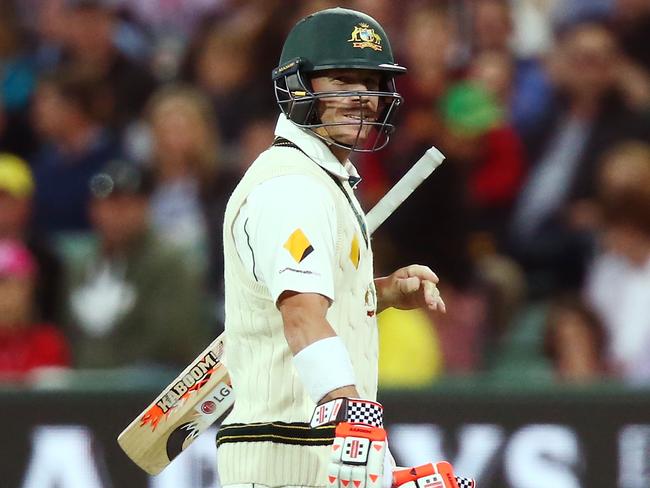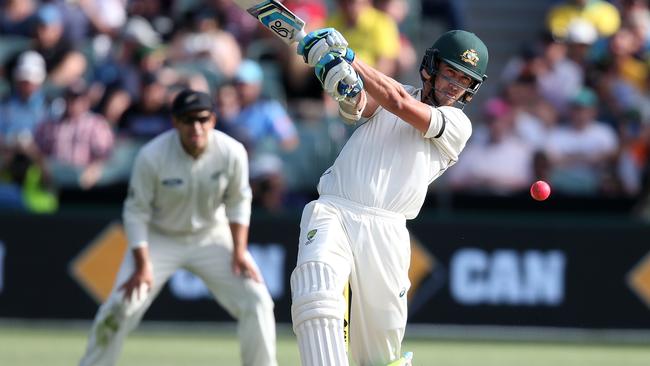Australia’s tactics prevailed on first day of historic day-night Test, says Ian Chappell
THERE was the historic nature of the occasion to be handled but in the end it was simple cricket strategy that prevailed, writes Ian Chappell.

Cricket
Don't miss out on the headlines from Cricket. Followed categories will be added to My News.
THERE was the historic nature of the occasion and the exploration of uncharted territory to be handled but in the end it was simple cricket strategy that prevailed in the inaugural day-night Test at the Adelaide Oval.
Whereas Australia’s bowlers were highly disciplined and ensured that New Zealand’s most dangerous batsmen were back in the pavilion long before the testing evening period arrived, the tourists failed to optimise their overs at the home side in cricket’s bewitching hour.
Pitching the much-discussed pink ball on a full length to take advantage of the healthy grass coverage, Mitchell Starc and Co rid themselves of the twin threats of Kane Williamson and Ross Taylor. Like many of their New Zealand teammates, the pair were dismissed after making a solid start and this ensured Australia only had to deal with lower-order players when batting was at its most difficult.
Batsmen always have to take full advantage of a start but when the difficult twilight period is looming it’s imperative players who are not only well-equipped but also well-established, are in occupation.

Despite only posting a moderate total, New Zealand still had an opportunity to claw their way back onto equal footing when they quickly erased the dangerous David Warner.
With the ball moving disconcertingly in the evening light and the prolific Steve Smith at the crease, New Zealand needed to maximise the overs bowled by twin spearheads Tim Southee and Trent Boult. The Kiwis should’ve been desperate to bowl at Australia’s brittle middle-order in the friendly conditions provided by daylight hours.
Instead of using Southee and Boult, Brendon McCullum - whose captaincy on this tour has confused rather than capitalised - opted for an extended spell from debutant spinner Mitchell Santner. Smith and the dogged Adam Voges survived the lesser challenge but Australia’s batsmen then faltered badly in conditions that should’ve been ideal.
On the historic first day the battle was decided by a familiar refrain; “the team with the upper-hand took advantage of their opportunities.”
As for the spectacle and historic nature of the contest, it was an unqualified success.
A record crowd of nearly fifty thousand added atmosphere to the occasion. The pink ball, while a little difficult to see from beyond the boundary in bright sunlight, suddenly appeared as if by magic when the weather clouded over and then became an iridescent beacon as the lights took effect.
There was some pre-match grumbling that a grassier pitch had to be prepared in order to preserve the ball. In reality, what transpired was the return of an old-time Test pitch with an even matt of grass and more importantly, promise of an even contest between bat and ball.
The motives for preparing such a pitch may have been questionable but the end result was a dynamic Test match and a template for future surfaces, whether the match is played in daylight hours or at night. For the Australians the disastrous collapse provided a sharp reminder of the batting nightmares they experienced recently in England.
Another interesting aspect emerged from this foray into uncharted territory. The change in conditions when the switch is made from daylight into night-time, is an opportunity for an enterprising captain to either reverse a poor start or capitalise on a promising beginning.
Any innovation that promotes imaginative captaincy and a genuine contest between bat and ball is an enormous boost for Test cricket.

The only players who will struggle with the day-night concept are those overly concerned with the statistical side of the game, as they’ll contemplate the adverse effect on their record. Those who enjoy a contest will make the conversion easily, as their sole purpose for playing is the pursuit of victory.
The choice of venue was a masterstroke. Adelaide has always been a traditional cricket city where fans turn out for Test matches and the weather lends itself to the Day/Night concept. The next step is to extend the playing hours, to further take advantage of the night time period.
I’m not sure whether playing in the cooler part of the day had something to do with it but the players were enlivened. Where the WACA Test moved at glacial speed the over rates in Adelaide were much improved.
All in all the opening stanza was a wonderful advertisement for the possibilities of Day/Night Test cricket. Cricket Australia is to be congratulated on the initiative and it now seems inevitable the concept will become part of the calendar not only here, but in other parts of the world.
In no time, players and fans will be wondering why it took so long to reach this point. Having played in Day/Night Super Tests during World Series Cricket back in 1978-79, I’m wondering the same thing.
Originally published as Australia’s tactics prevailed on first day of historic day-night Test, says Ian Chappell


